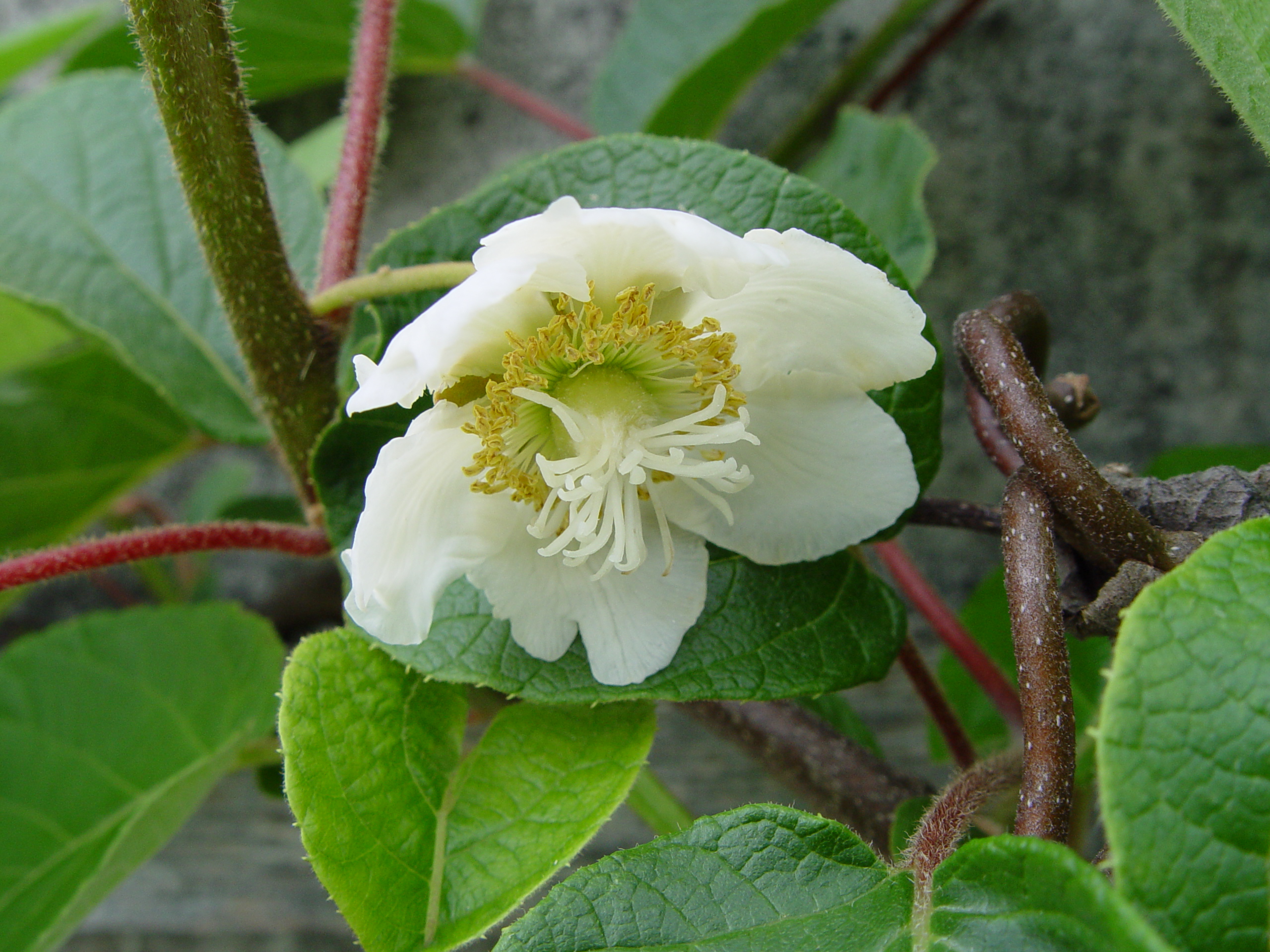- Actinidiaceae
Taxobox
name = Actinidiaceae

image_width = 240px
image_caption = "Actinidia deliciosa "
regnum =Plantae
divisio = Magnoliophyta
classis =Magnoliopsida
ordo =Ericales
familia = Actinidiaceae
familia_authority = Hutchinson
type_genus = "Actinidia "
type_genus_authority = Lindl.
subdivision_ranks = Genera
subdivision = "Actinidia "
"Clematoclethra "
"Saurauia "Actinidiaceae, or the Chinese Gooseberry family, is a small family of
plant s. It includes three genera and about 360species . It is a member of the orderEricales . [Anderberg et al. "Phylogenetic Relationships in the Order Ericales S.L.: Analyses of Molecular Data from Five Genes from the Plastd and Mitochondrial Genomes" "American Journal of Botany" 89(4): 677-687. 2002]Distribution
They are temperate and subtropical woody
vine s, shrubs andtree s, native toAsia ("Actinidia or kiwifruit,Clematoclethra ,Saurauia ") andCentral America andSouth America ("Saurauia " only). "Saurauia" is with its 300 species the largest genus in this family. Although now confined to Asia and tropical Central and South America, there is evidence that in the past the family had a wider distribution. The now extinct genus "Parasaurauia" is thought to have belonged to the Actinidiaceae and was located inNorth America during th earlyCampanian . [Keller et al. "Fossil Flowers and Fruits of the Actinidiaceae from the Campanian (Late Cretaceous) of Georgia" "American Journal of Botany" Vol. 83, No. 4. (1996) pp. 528-541]Characterisitics
The plants are usually small trees or shrubs, or sometimes vines ("Actinidia"). The alternate, simple, spiral leaves have serrate or entire margins. They lack
stipule s or are minutely stipulate. They are often beset with rather flattened bristles.The
flower s grow solitary or are aggregated in terminalcyme s, with freesepal s andpetal s. Except for members of the genus "Clematoclethra " which have 10 stamens, thestamen s are numerous and originally attached at the back. [Keller et al. "Fossil Flowers and Fruits of the Actinidiaceae from the Campanian (Late Cretaceous) of Georgia" "American Journal of Botany" Vol. 83, No. 4. (1996) pp. 528-541] They invert just before the flower starts expanding, so that their bases become apical.The plants may be
monoecious ,dioecious or hermaphroditic. The fruit is usually aberry , such as the ediblekiwifruit , a cultivar from the genus "Actinidia ".Evidence supporting placement within the Ericales
Before genetic evidence appeared in the last 10 years, the placement of the Actinidiaceae within the
Ericales was highly controversial. The USDA plants database, a resource that is considered authoratative, still places the Actinidaceae within theTheales , an order which has been shown not to bemonophyletic . [The Angiosperm Phylogeny Group "An Ordinal Classifcation for the Families of Flowering Plants" "Annals of the Missouri Botanical Garden" Vol. 85, No. 4. (1998), p. 531-553] Placement of the Actinidiaceae within theEricales has been strongly supported by genetic evidence over the past 10 years, and contrary to previous thought, it is not a basal member of theEricales . Multiple studies using genetic evidence now firmly place the Actinidiaceae in the Ericoidclade , amonophyletic group consisting of theEricaceae , theCyrillaceae , theClethraceae , theSarraceniaceae , and theRoridulaceae . Furthermore, genetic evidence points to the Actinidiaceae being sister to theRoridulaceae , and with theRoridulaceae andSarraceniaceae , forming another, smaller,monophyletic group. [Schoengerger et al. "Molecular Phylogenetics and Patterns of Floral Evolution in the Ericales" "International Journal of Plant Sciences" Mar 2005; 166, 2; pg. 265]Evidence supporting monophyly of the Actinidiaceae
What genera were to be placed in the Actinidiaceae before recent genetic and micromophological studies emerged was highly controversial. Before recent evidence, the genus "Sladenia" was often placed within the Actinidiaceae. Also, "
Saurauia " was sometimes considered its own family. Thus, before 10 years ago when more detailed studies started, it was considered that there could be anywhere from 2-4 genera within the Actinidiaceae. Micromorphological characters have confirmed that "Sladenia" does not belong in the Actinidiaceae. Furthermore, biological characteristics of the cells, and molecular evidence, have confirmed that the 3 genera currentlycircumscribed in the Actinidiaceae, the "Clematoclethra ", "Saurauia ", and "Actinidia " do indeed form amonophyletic group. [Li et al. "Molecular Phylogeny and Infrageneric Classification of "Actinidia" (Actinidiaceae)" "Systematic Botany" (2002), 27(2): pp. 408-415] [He et al. "The cytology of "Actinidia, Saurauia," and "Clematoclethra"(Actinidiaceae)" "Botanical Journal of the Linnean Society" 2005, Vol. 147, p. 369-374]References
External links
* [http://delta-intkey.com/angio/www/actinidi.htm Actinidiaceae] in [http://delta-intkey.com/angio/ L. Watson and M.J. Dallwitz (1992 onwards). The families of flowering plants.] http://delta-intkey.com
* [http://plants.usda.gov/java/ClassificationServlet?source=profile&symbol=Theales&display=31 Theales Order] in the USDA Plants Database
Wikimedia Foundation. 2010.
